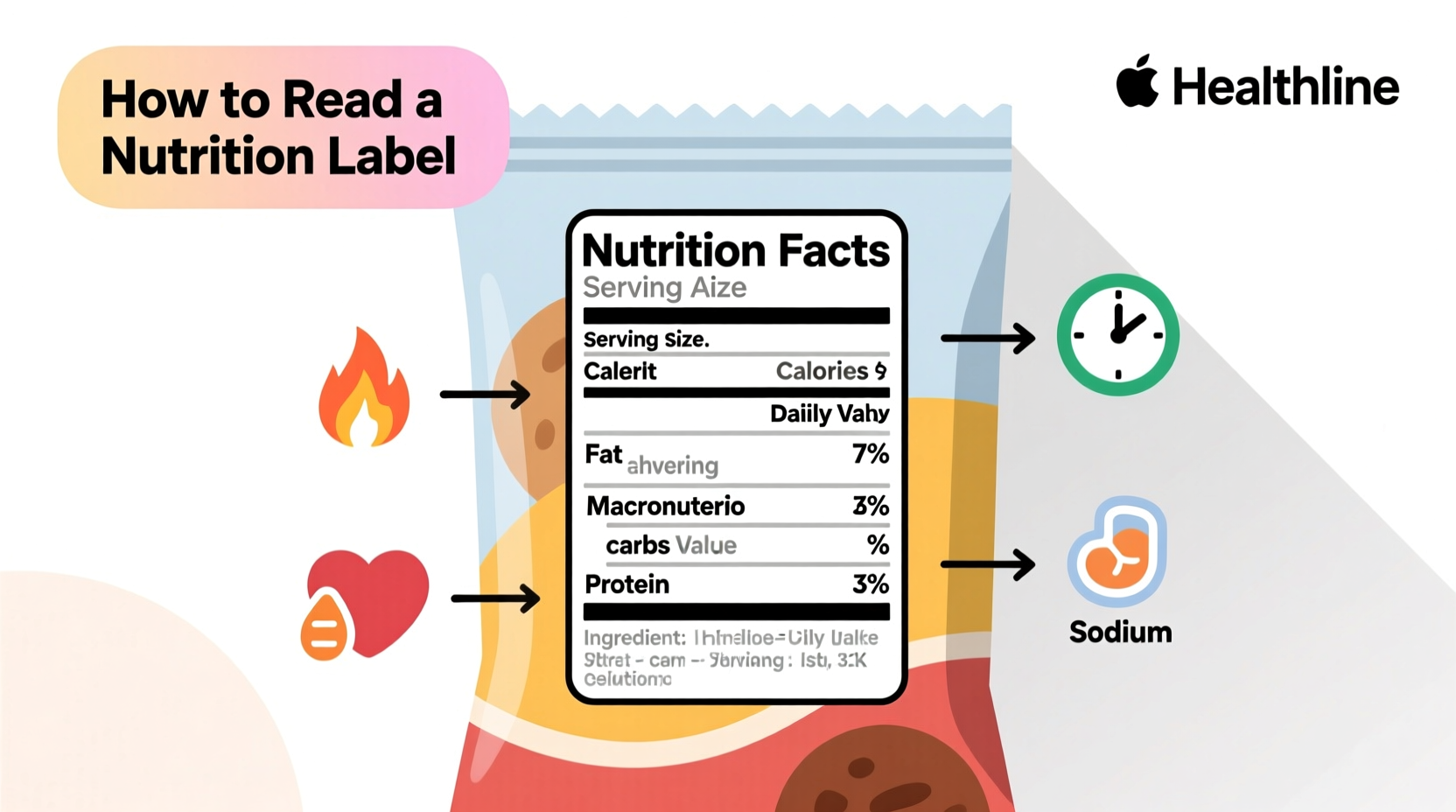Reading a nutrition label starts with checking the serving size first, then examining calories, key nutrients to limit (like saturated fat, sodium, and added sugars), and nutrients to get more of (like fiber, vitamins, and minerals). Always compare the % Daily Value (%DV) to understand how much a nutrient contributes to your daily needs—5% or less is low, 20% or more is high.
Understanding nutrition labels transforms how you make food choices. With obesity rates rising and chronic diseases linked to poor dietary habits, knowing how to decode that small panel on food packaging becomes a critical life skill. This guide provides a practical, step-by-step system you can use immediately at the grocery store.
The 5-Step System for Reading Nutrition Labels Like a Pro
Step 1: Always Start with Serving Size (The Most Overlooked Element)
Before examining any other information, check the serving size and servings per container. Manufacturers sometimes list unrealistically small serving sizes to make nutritional values appear better. If a package contains 2.5 servings but you typically eat the whole thing, you'll consume 2.5 times the calories and nutrients listed.
Consider this real-world example: A popular snack bar might list 200 calories per bar, but the label reveals it contains two servings. Eating the entire bar means consuming 400 calories, not 200. This simple oversight derails many people's dietary goals.
Step 2: Understand Calories in Context
Calories provide energy, but their value depends on what you're getting for those calories. A 200-calorie snack packed with fiber and protein offers more nutritional value than a 200-calorie sugary treat. The FDA recommends using 2,000 calories as a general guide for daily intake, but your personal needs may vary based on age, sex, height, weight, and physical activity level.
| Nutrient | Limit These | Get More of These |
|---|---|---|
| Total Fat | Saturated Fat, Trans Fat | Monounsaturated, Polyunsaturated |
| Cholesterol | — | — |
| Sodium | — | — |
| Total Carbohydrate | Added Sugars | Dietary Fiber |
| — | — | Vitamins A, C, D, Calcium, Iron, Potassium |
Step 3: Evaluate the Nutrient Profile Strategically
Nutrition labels separate nutrients into two categories: those you should limit and those you generally need more of. Pay special attention to:
- Saturated fat: Keep below 10% of daily calories (about 20g for a 2,000-calorie diet)
- Trans fat: Avoid completely—any amount increases heart disease risk
- Sodium: Aim for less than 2,300mg daily (1,500mg is ideal for most adults)
- Added sugars: Limit to less than 10% of daily calories (about 50g)
- Fiber: Target at least 25g daily for women, 38g for men
The updated nutrition facts label, implemented by the FDA in 2020, now clearly distinguishes between natural sugars and added sugars—a critical improvement for making informed choices.
Step 4: Decode the % Daily Value (%DV) Correctly
The %DV shows how much a nutrient in a serving contributes to your daily diet. Use this quick reference:
- 5% DV or less per serving is considered low for that nutrient
- 20% DV or more per serving is considered high
For nutrients to limit (saturated fat, sodium, added sugars), aim for products with lower %DV. For nutrients to get more of (fiber, vitamins, minerals), choose products with higher %DV. Remember that these percentages are based on a 2,000-calorie diet—adjust accordingly if your needs differ.

Step 5: Read the Ingredient List Strategically
Ingredients are listed by weight from most to least. Watch for:
- Hidden sugars (high-fructose corn syrup, cane juice, maltose, dextrose)
- Unrecognized chemical additives
- Whole food ingredients versus refined components
If sugar appears in multiple forms within the first three ingredients, the product is likely high in added sugars even if the total sugar count seems moderate. Similarly, products listing "whole wheat" as the first ingredient contain more beneficial fiber than those with "enriched wheat flour" at the top.
Nutrition Label Evolution Timeline
Nutrition labeling has evolved significantly to provide more useful information:
- 1990: Nutrition Labeling and Education Act requires standardized nutrition facts panels
- 2006: Added trans fat disclosure after research linked it to heart disease
- 2016: FDA announces major label redesign after scientific review
- 2020: Updated labels become mandatory with larger calorie counts, added sugars line, and updated daily values
This evolution reflects growing understanding of nutrition science and consumer needs. The current label design specifically addresses common misinterpretations from previous versions.
Avoiding Common Label Reading Mistakes
Even health-conscious shoppers make these critical errors:
- Ignoring serving size inflation: Many "single-serve" packages actually contain multiple servings
- Misunderstanding "low-fat" claims: These products often compensate with added sugars
- Overlooking the ingredient list: A "healthy" label doesn't guarantee quality ingredients
- Focusing only on calories: 100-calorie snack packs may lack nutritional value
Special Considerations for Specific Health Needs
Your approach to reading labels should adapt to your health situation:
- For heart health: Prioritize low sodium (under 140mg per serving) and no trans fat
- For diabetes management: Focus on total carbohydrates and fiber content
- For weight management: Check both calories and protein/fiber content for satiety
- For digestive health: Look for at least 3g of fiber per serving
According to the American Heart Association, most Americans consume nearly double the recommended sodium limit, largely from processed foods. Reading labels consistently can help reduce this dangerous excess.
Practical Label Reading Quick Reference
Keep this checklist in mind during your next grocery trip:
- ✓ Serving size first—always check how many servings are in the package
- ✓ Calories per actual portion you'll eat
- ✓ Added sugars below 10g per serving
- ✓ Saturated fat below 3g per serving
- ✓ Sodium under 200mg per serving for processed foods
- ✓ Fiber at least 3g per serving
- ✓ Short ingredient list with recognizable components











 浙公网安备
33010002000092号
浙公网安备
33010002000092号 浙B2-20120091-4
浙B2-20120091-4